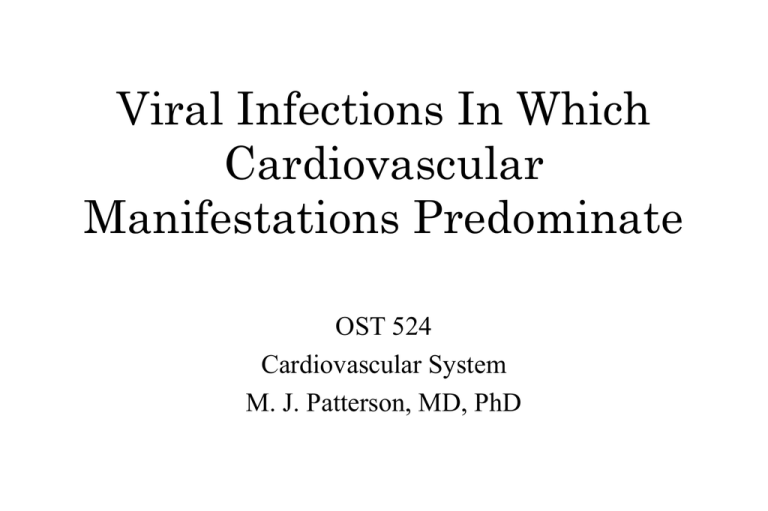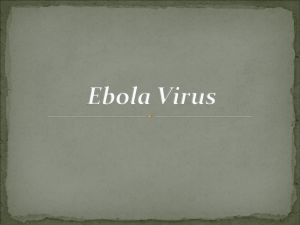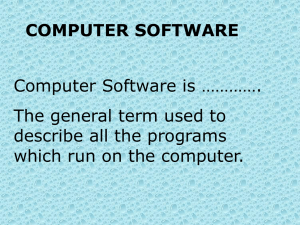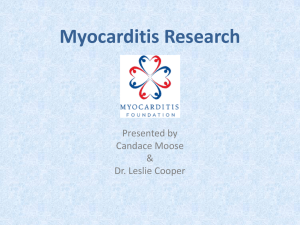
Viral Infections In Which
Cardiovascular
Manifestations Predominate
OST 524
Cardiovascular System
M. J. Patterson, MD, PhD
Myocarditis-Pericarditis
•
•
•
•
•
•
•
Etiology: cardiotropism
Pathology
Clinical features
Diagnosis
Immunity
Epidemiology
Prophylaxis and treatment
Viral Infections with Involvement of the
Hematopoeitic and Lymphatic Systems
•
•
•
•
•
•
Epstein Barr Virus (EBV): Infectious mononucleosis
EBV: Burkitt's lymphoma
Human herpes HHV6, HHV7, HHV8
Human Parvovirus B19: transient aplastic anemia
Bone marrow failure
Malignant association - other
CMV and cardiovascular disease
Cardiac Malformations
as Part of Rubella Embryopathy
• Etiology: vascular endothelial tropism
Myocarditis - Pericarditis
• Etiology
– Virus should always be part of the differential
diagnosis of primary acute myocarditis
– Clinical evidence suggesting involvement of the heart
has been reported for essentially all known viruses
– Cardiotropism: viral receptor substances
Myocarditis - Pericarditis
• Etiology
– Most commonly incriminated viruses: enterovirus 30 nm, RNA:
Coxsackie B, Coxsackie A, ECHO, polio
• Cox B esp 2,3,4,5
• Cox A
• ECHO
– Occasionally myopericardial involvement in course of any viral
infection
• often manifested only by EKG modification
• does not necessarily imply an anatomic alteration of the myocardium
Viruses That Have Been Shown to
Cause Myocarditis
• Common
–
–
–
–
–
Coxsackievirus A
Coxsackievirus B
Echovirus
Human immunodeficiency virus
Influenza
• Less Common
–
–
–
–
–
–
–
–
–
Adenovirus family
Arbovirus
Epstein-Barr virus
Herpes simplex virus type 1
Human cytomegalovirus
Measles virus
Respiratory syncytial virus
Rubella virus
Varicella-zoster virus
Myocarditis - Pericarditis
• Pathology
– Relatively nonspecific
– Cardiac lesions: dilation and hypertrophy, esp. of left ventricle,
edema, interstitial infiltrate of mononuclear cells, isolated
necrosis of myocardial fibers, inflammation and necrosis
resulting in foci for sclerosis
– Diffuse cellular necrosis in other organs in coxsackie infections
– Pericarditis rarely occurs without clinical or histologic evidence
of myocarditis
– Immune-mediated pathology
Circulation 89:2422, 1994
Inflammatory Cytokines
Cytokine
Principal Cell of Origin
Principal Action
IL-2
Activated T cell
Autocrine T-cell growth factor. Stimulates
production of IL-2, TNF-a, Activates natural killer
cells
IL-1
Activated macrophages,
endothelial cells
Stimulates T-cell activation. Induction of
inflammatory metabolites. Activates endothelial
cells and stimulates cytokine production.
IL-6
Monocytes, macrophages, T
cells, endothelial cells
Stimulates differentiation of B cells. Stimulates
production of plasma proteins by hepatocytes.
INF
Activated T cells
Activates monocytes. Increases production of
oxygen radicals by macrophages. Increases
expression of MHC class I and II antigens.
TNF- a
Activated macrophages
Activates endothelial cells. Stimulates production of
cytokines. Can induce direct lysis of some cell
types.
IL-8
Activated macrophages,
lymphocytes, endothelial cells
Chemo-attractant for neutrophils and causes
neutrophil stimulation.
Myocarditis - Pericarditis
• Clinical features: relatively rare form of heart
disease in U.S., generally acute and benign
– Occurrence - a disease of newborns and infants;
sometimes older children, occasionally in adults
– Antecedent URI---1-30d before symptoms refer to
heart
– subacute or chronic cardiopathy
Signs and Symptoms of
Viral Myocarditis
• Symptoms
–
–
–
–
–
Fatigue
Dyspnea
Palpitation
Chest pain
Syncope
• Signs
– Pericardial rub
– Sinus tachycardia
– Atrial or ventricular
arrhythmias
– Conduction disturbances
– Cardiomegaly
– Right or left S3 or S4 gallop
sounds
– Congestive heart failure
New England Journal of Medicine 343:1391 2000
Infectious
Causes of Pericarditis
• Bacterial
–
–
–
–
–
–
–
–
–
–
–
–
–
Actinomyces
Bacteroides fragilis
Borrelia burgdorferi
Brucella
Campylobacter
Chlamydia
Enterococcus sp.
Escherichia coli
Fusobacterium nucleatum
Haemophilus influenzae
Klebsiella pneumoniae
Legionella
Listeria monocytogenes
–
–
–
–
–
–
–
–
–
–
–
–
–
Mycobacterium avius-intracellulare
Mycobacterium tuberculosis
Mycoplasma pneumoniae
Neisseria gonorrhea
Neisseria meningitis
Nocardia asteroides
Peptostreptococcus
Pseudomonas aeruginosa
Prevotella sp.
Salmonella
Staphylococcus aureus
Streptococcus pneumoniae
Streptococcus (group C)
Infectious
Causes of Pericarditis
• Viral
–
–
–
–
–
–
–
–
–
–
–
–
Adenovirus
Coxsackie A
Coxsackie B
Cytomegalovirus
Echovirus
Epstein Barr virus
Hepatitis B
Herpes simplex
HIV
Influenza
Mumps
Varicella Zoster
• Fungal
–
–
–
–
–
–
Aspergillus
Blastomyces dermatitidis
Candida
Coccidioides Immitis
Cryptococcus neoformans
Histoplasma capsulatum
• Parasitic
–
–
–
–
Entamoeba histolytica
Schistosoma
Toxocara canis
Toxoplasma gondii
Noninfectious
Causes of Pericarditis
• Collagen vascular diseases
–
–
–
–
–
–
–
–
–
Rheumatic fever
Rheumatoid arthritis
Scleroderma
CREST syndrome
Systemic lupus erythematosus
Sarcoidosis
Sjögren's syndrome
Mixed connective tissue disease
Vasculitis, including temporal
arteritis
– Polyarteritis
• Drug-induced
–
–
–
–
–
Minoxidil
Bleomycin
Procainamide
Hydralazine
Azathioprine
• Inflammatory bowel disease
– Ulcerative colitis
– Crohn’s disease
Noninfectious
Causes of Pericarditis
• Neoplastic
– Primary (benign or malignant)
– Metastatic to pericardium
• Other
–
–
–
–
–
–
–
–
–
Fabry’s disease
Uremia
Löffler's syndrome
Thalassemia
Acute myocardial infarction
Kawasaki’s Disease
Dissection aortic aneurysm
Post-radiation
Pregnancy
• Other
– Myxedema
– Dego's disease
– Cardiac Injury
• Traumatic
• Dressler’s syndrome
–
–
–
–
–
–
–
Stevens-Johnson syndrome
Polymyositis
Dermatomyositis
Behçet's syndrome
Addisonian crisis
Gout
Whipple’s disease
Criteria for Diagnosis of
Myopericarditis
• ECG manifestation
–
–
–
–
ST-T or T wave changes or
Low QRS voltage or
A-V conduction defects or
Intraventricular conduction
defects
• Plus 2 or more symptoms
– Precordial left-sided chest
pain
– Signs and symptoms of
congestive heart failure
– Cardiomegaly
– Fever
– Pericardial friction rub
Myocarditis - Pericarditis
• Diagnosis
– Appropriate specimens for viral diagnosis
• Isolation of agent: pericardial fluid, T.S., R. S. first few
days of illness, heart tissue at autopsy or biopsy
• Serology: 4-fold rise in titre by neutralization,
complement fixation, hemagglutination inhibition; allows
identification of a specific recent infection which is
circumstantial evidence with a high index of suspicion
when correlated with clinical findings.
– Etiological diagnosis of viral carditis is difficult
Disease Category: Myocarditis-pericarditis
Source
Viral Agents Usually
Sought
Throat
Swab
Rectal
Swab
CSF Urine
Pericardial
Fluid
Other
Enterovirus
++
+++
-
-
++
*
Myxovirus
+++
-
-
-
++
*
Paramyxovirus
+++
-
-
-
++
*
• *Because it is frequently very difficult to isolate and/or associate these agents
with the disease in question, it is emphasized that serological tests are
particularly important to insure a diagnosis.
• N.B. In general, it is important to remember that viral shedding often diminishes
rapidly after the onset of illness; therefore, it is important to attempt to collect
specimens as early as possible - including an acute serum sample.
Criteria for Viral Myocarditis
• High-order association
– Isolation of virus from myocardium, endocardium or
pericardial fluid
or
– Demonstration of viral antigen in the myocardium
endocardium or pericardium by immunofluorescent or
immunoperoxidase assay, etc.
Criteria for Viral Myocarditis
• Moderate-order association
– Isolation of virus from pharynx or feces, and a fourfold rise in
type-specific neutralizing, hemagglutination-inhibiting or
complement-fixing antibodies
or
– Isolation of virus from pharynx or feces, and a concomitant titer
in serum of 1/32 or more of type-specific IgM-neutralizing or
hemagglutination-inhibiting antibodies.
Criteria for Viral Myocarditis
• Low-order association
– Isolation of virus from pharynx or feces.
– A fourfold rise in type-specific neutralizing,
hemagglutination inhibiting, or complement-fixing
antibodies
– A single serum with a titer of 1/32 or greater of typespecific IgM neutralizing or hemagglutination
inhibiting antibodies
Histologic Criteria for the Classification
of Viral Myocarditis (“Dallas Criteria”)
• Initial Biopsy
– Active myocarditis with or without fibrosis
• Presence of inflammatory infiltrate and damage of adjacent myocytes
• Frank necrosis that may consist of vacuolization, irregular cellular outlines, and
cellular disruption with lymphocytes closely applied to the cell surface
• Uninvolved myocardium often appears normal
– Borderline myocarditis (may require biopsy)
• Inflammatory infiltrate or myocyte damage not seen on light microscopy
• Diagnostic changes evident on additional cuts of original biopsy, which suggest
active myocarditis and do not require a repeat biopsy
– No evidence of myocarditis
Histologic Criteria for the Classification
of Viral Myocarditis (“Dallas Criteria”)
• Subsequent Biopsies
– Ongoing myocarditis
• Degree of abnormality is equal to or worse than that of the original
biopsy
– Resolving myocarditis
• Inflammatory infiltrate is less and repair is evident
– Resolved myocarditis
• No remaining inflammatory infiltrate and no evidence of persistent
cellular necrosis
Myocarditis - Pericarditis
• Immunity:
– Need to see 4-fold rise due to ubiquity of the agents
and persistence of titers
– Chronicity postulated due to lesions representing an
immune response
Myocarditis - Pericarditis
• Epidemiology:
–
–
–
–
Season: random through year
Spread: fecal-oral and respiratory
Age
Other factors:
•
•
•
•
•
•
•
Physical exercise
Nutrition
Volume load on circulatory system
Pregnancy
Sex
Corticosteroids
Diabetes
The Journal of Experimental Medicine 143:1239, 1976
Myocarditis - Pericarditis
• Prophylaxis and treatment:
– Chronic sequelae constitute an argument for search for
specific treatment and prevention
– Controlled studies of effects of therapeutic measures
are needed
– Bed rest and supportive therapy
Proposed Therapies of Postviral and
Idiopathic Myocarditis
Category
Therapy
Comment
Conventional therapy of
congestive heart failure
Digitalis and diuretics
Digitalis may decrease interleukin1b and tumor necrosis factor-a
Angiotensins-converting enzyme
inhibitors and angiotensin-II
receptor antagonists
May have a direct
immunomodulatory effect
Bed rest, b-blockers
Both beneficial and deleterious
effects in murine models
Corticosteroids
Documented use in humans
Cyclosporine
Documented use in humans
Azathioprine
Documented use in humans
Immunosuppressive therapy
FK506
OKT3
Many others
Documented use in humans
Proposed Therapies of Postviral and
Idiopathic Myocarditis
Category
Therapy
Comment
Immunomodulatory
therapy
Gamma globulin
Documented use in humans
Coxsackie B3 vaccine
FK565
Immunostimulant action inhibits replication
Immunoadsorption
Antiviral therapy
Ribavirin
Interferon
Anticytokine therapy
Anti-tumor necrosis
factor antibody
Vesnarinone
One of several phosphodiesterase inhibitors that inhibit
cytokine release
Amiodarone
Miscellaneous
Margatoxin
One of several T-cell potassium-channel blockers
Calcium antagonists
May prevent microvascular spasm
N-monomethyl-l-arginine
Inhibition of nitric oxide synthesis may prevent myocyte
injury and reversible depression
Viral Infections with Involvement of the
Hematopoietic and Lymphatic Systems
Epstein-Barr Virus,
Infectious mononucleosis
• EBV herpes group virus, lymphotropic
– 1889 Pfeiffer - "drusenfieber" - glandular fever
– 1968 - Henle's: after long history attributed an essential
virus role in the disease to a virus of the herpes group
– EB virus = Epstein Barr virus, a herpes type virus named for
cell line in which it was first detected
– Transforms (i.e., releases from normal regulatory
control) human B lymphocytes which then interact with the
T lymphocytes (atypical lymphs of mono)
New England Journal of Medicine
343:482 2000
New England Journal of Medicine
343:483 2000
JAMA 278:511, 1997
Various Forms of Infection by
EB Virus in Man
• Productive replicative infection
– Virus replication leading to cell death (as in the oropharynx of some infected
individuals)
• Nonproductive infection
– Can be activated to productive cycle
• Latent infection
– Virus genome express to give LYDMA and EBNA (as in peripheral B cells of all
infected individuals)
• Malignant transformation
– Virus genome expressed to give early antigen and cell changes of malignancy (as in
BL showing LYDMA, EBNA, EMA, and NPC showing EBNA)
• In marmosets EB virus certainly induces malignant transformation with EBNA
expression to give malignant lymphomas
Pediatrics in Review
7:36, 1985
Clinical Findings in Heterophile AntibodyPositive Infectious Mononucleosis
No. of Patients
270
56,200
100
100
•Sore throat
88
70
NS
NS
•Malaise
50
43
NS
76
•Headache
62
37.5
NS
55
•Nausea, vomiting, anorexia
27
7.1
NS
43
•Myalgia
21
12.5
NS
NS
Symptoms (% of patients)
Clinical Findings in Heterophile AntibodyPositive Infectious Mononucleosis
No. of Patients
270 56,200 100 100
Signs (% of patients)
•Fever
65
97.5
94
79
•Lymphadenopathy
>90
100
94
95
•Pharyngitis
85
83
NS
91
•Exudative
63
22
69
49
•Splenomegaly
50
NS
63
51
•Palpebral edema
18
36
11
5
•Palatal petechiae
47
25
NS
13
•Rash
25
3
15
12
•Jaundice
10
8
8
0
Symptoms and Signs in Nine Patients with
Spontaneous Cytomegalovirus Mononucleosis
Symptoms
Malaise
Fever
Number of Patients
9
8
Chills
Myalgia
Sore throat
Headache
6
6
5
4
Anorexia
Abdominal pain
3
2
Symptoms and Signs in Nine Patients with
Spontaneous Cytomegalovirus Mononucleosis
Signs
Number of Patients
Pharyngeal erythema
5
Lymphadenopathy
5
Rash
5
Splenomegaly
3
Hepatomegaly
0
Exudative pharyngitis
0
Clinical Disorders Associated Etiologically
with Epstein-Barr Virus
Primary infection
Evidence for etiology
(+ to ++++)
•Infectious mononucleosis
++++
•Congenital infection with fetal abnormalities
++++
•Acute neurologic disease (Guillain Barré, Bell’s Palsy,
meningoencephalitis)
+++
•Acquire agammaglobulinemia, aplastic anemia,
lymphoma
+++
•Lymphoproliferative lesions including lymphomas in
renal and other organ transplant recipients
++
•Tonsillopharyngitis
++
•Thrombocytopenia
++
•Pneumonia
++
•Reye’s syndrome
++
•Hemophagocytic syndrome
+
•Acute arthritis
+
Clinical Disorders Associated
Etiologically with Epstein-Barr Virus
Reactivated infection
Evidence for etiology
(+ to ++++)
•Lymphoproliferative lesions including lymphomas in
renal and other organ transplant recipients
++
•Burkitt’s lymphoma, nasopharyngeal carcinoma
++
•Chronic mononucleosis or chronic (symptomatic) EBV
infection
++
•Rheumatoid arthritis
+
•Acquired immunodeficiency syndrome (AIDS) and
AIDS-related complex
+
Complications of Infectious
Mononucleosis
• Neurologic
–
–
–
–
–
–
–
–
–
–
Meningoencephalitis
Aseptic meningitis
Guillain-Barré syndrome
Facial or other peripheral nerve
paralysis
Transverse myelitis
Optic neuritis
Seizures
Coma
Acute psychosis
Acute cerebellar ataxia
• Hematologic
–
–
–
–
–
Autoimmune hemolytic anemia
Thrombocytopenic purpura
Granulocytopenia
Pancytopenia
DIC
Complications of Infectious
Mononucleosis
• Cardiac
– Myocarditis
– Pericarditis
• Respiratory
– Pharyngeal edema with
airway obstruction
– Interstitial pneumonia
– Pleuritis
• Hepatic
– Cholestatic jaundice
– Massive hepatic necrosis
causing liver failure
• Splenic Rupture
Signs and Symptoms of Hemophagocytic
Lymphohistiocytosis
Organ
System
Clinical Findings
Laboratory Findings
General
Fever, edema
Bone
Marrow
Anemia
Hemophagocytosis, cytopenia 2 lines
Immune
system
Splenomegaly, lymphadenopathy
↓ Natural killer cell activity, ↑ serum
cytokines, ↑ soluble IL-2 receptor
Liver
Jaundice, hepatomegaly
↑ Triglycerides, ↓ fibrinogen, ↑ ferritin,
↑ LDH, coagulopathy, ↑ transaminases,
↑ bilirubin, DIC
Lungs
Cough
Infiltrates on chest x-ray
Skin
Generalized maculopapular rash
CNS
Irritability, stiff neck, seizure,
CN palsy, ataxia
↑ Protein in CSF, hemophagocytosis in
CSF
“Chronic Mononucleosis”
Clinical Findings and Reported Complaints Among 39 Patients with
Suspected Chronic Infectious Mononucleosis
Complaint
Patients
No. (%)
Complaint
Patients
No. (%)
Fatigue
Nervous system
Depression
Pharyngitis
Fever
Lymphadenopathy
Myalgia
29 (74)
28 (73)
27 (70)
25 (64)
24 (63)
23 (59)
21 (56)
Dyslogia
Arthritis/arthralgia
Splenomegaly
Weight loss
Rash
Hepatomegaly
20 (53)
19 (51)
9 (22)
9 (22)
5 (12)
4 (10)
CFS due to stress
and unknown factors
? Stress +
EBV-related
CEBV
Lake Tahoe CFS
Severe CEBV
(high VCA, EA,
absent EBNA-1
Antibodies)
CMV
HHV-6
HIV
Lyme disease
Timeline graph from 1800 to the present of other
diseases with symptoms very similar to CFS
Febricula, Vapors
Neurasthenia
Da Costa's Syndrome
Chronic Brucellosis
Hypoglycemia
Myalgic Encephalomyelitis, Epidemic Neuromyasthenia
Total Allergy Syndrome
Chronic Mononucleosis, Chronic EBV
Chronic Candidiasis
Postviral Fatigue Syndrome
Chronic Fatigue Syndrome
1800
1850
1900
1950
2000
Summary of the Working Definition of CFS
• Major criteria
– Persistent or relapsing fatigue or easy fatigability that
does not resolve with bed rest and is severe enough to
reduce average daily activity by ≥ 50
– Satisfactory exclusion of other chronic conditions,
including preexisting psychiatric disease
Summary of the Working Definition of CFS
• Minor criteria
–
–
–
–
–
–
–
–
–
Mild fever (37.5-38.0ºC oral if document by patient) or chills
Sore throat
Lymph node pain in anterior or posterior cervical or axillary chains
Unexplained, generalized muscle weakness
Muscle discomfort, myalgia
Prolonged (≥ 24 h) generalized fatigue after previously tolerable levels of exercise
New generalized headaches
Migratory, noninflammatory arthralgia
Neuropsychologic symptoms: photophobia, transient visual scotomata, forgetfulness,
excessive irritability, confusion, difficulty thinking, inability to concentrate or
depression
– Sleep disturbance
– Patient description of initial onset of symptoms as acute or subacute
Summary of the Working Definition of CFS
• Physical findings (documented by physician at
least twice ≥ 1 month apart)
– Low-grade fever (37.6-38.6ºC oral or 37.8-38.8ºC
rectal)
– Non-exudative pharyngitis
– Palpable or tender anterior or posterior cervical or
axillary lymph nodes (<2 cm diameter)
Epstein-Barr Virus,
Infectious mononucleosis
• Laboratory diagnosis
– Blood smear with "atypical" lymphocytes
– Heterophile agglutination (nonspecific reaction with
abs which agglutinate HRBC or SRBC)
– Anti EB virus abs
Clinical and laboratory manifestations of
infectious mononucleosis. The predominant
symptoms, signs, laboratory changes and EB
virus-specific serologic findings during classic
infectious mononucleosis are depicted in four
panels. Arrow A indicates asymptomatic
prodrome; arrow B, peak of clinical illness; and
arrow C, early convalescence, during which the
EB virus-associated neuropathies usually occur.
Pediatrics in Review
7:37, 1985
Disorders Associated with
>20% Atypical Lymphocytes
• EBV mononucleosis
• Viral hepatitis
• CMV mononucleosis
Disorders Associated with
<20% Atypical Lymphocytes
• Infections
–
–
–
–
–
–
–
–
–
Mumps
Varicella
Rubeola
Rubella
Roseola infantum (HHV6)
Herpes simplex
Herpes zoster
Influenza
Tuberculosis
–
–
–
–
–
–
–
–
Brucellosis
Toxoplasmosis
Syphilis
Smallpox
Malaria
Babesiosis
RMSF
Ehrlichiosis
Disorders Associated with
<20% Atypical Lymphocytes
• Non-Infectious
– Drug hypersensitivity
reactions
– Drug fever
– Dermatitis herpetiformis
– Radiation therapy
– Stress
– Lead intoxication
Interpretation of EBV Serology
IgG-VCA
IgM-VCA
EBV Nuclear
Antigen
EBV Early
Antigen
No evidence of
infection
<10
<10
<2
<10
Acute
infection
>10
≥10
<2
≥20
Convalescent
infection
>10
Variable
>2
Variable
Remote past
infection
≥10
<10
>2
≤20
EBV
Toxoplasmos
is
Rubella
HIV
CMV
HHV-6
HAV/HBV
•Pharyngitis
++
(exudative/
non-exudative)
+
(nonexudative)
+
(nonexudative)
±
(nonexudative)
+
(nonexudative)
+
(nonexudative)
±
(nonexudative)
•Lymphadenopathy
Bilateral
posterior
cervical/genera
lized lymphadenopathy
Unilateral
single node
involvement
Occipital
postauricular
generalized
lymphadenopathy
Localized
node
enlargement
generalized
lymphadenopathy
Bilateral
posterior
cervical/
generalized
lymphadenopathy
Bilateral
posterior
cervical
adenopathy
None/mild
general
adenopathy
+++
±
-
-
±
±
-
+
-
±
+
+
±
20%
<5%
<5%
-
≥ 20%
<10%
<5%
• SGOT/SGPT
+
±
-
-
+
+
+++
•Thrombocytopenia
+
-
±
+
+
±
-
•Mono spot
+
-*
-*
-*
-*
-*
-*
Physical Findings
•Splenomegaly
Lab Abnormalities
•Leukopenia
•Atypical
lymphocytosis
*rarely false positive Mono spot test
Epstein-Barr Virus,
Infectious mononucleosis
• Epidemiology:
– Children and young adults
– Droplet spread probably
– Communicability period and incubation period
Epstein-Barr Virus,
Infectious mononucleosis
• Immunity:
– EB virus (or one closely related antigenically)
might operate in an opportunistic way whenever it
finds actively proliferating lymphocytes
Epstein-Barr Virus,
Infectious mononucleosis
• Prophylaxis and treatment:
– Symptomatic and supportive
– Acyclovir
– Corticosteroids
Burkitt's disease
• African lymphoma starting as jaw or orbital tumor, then
involvement of maxillary bones, kidneys, ovaries,
thyroid, parotid
• Epidemiology
– Central Africa
– Case concentration: children 7-8 years old
• Associated etiology
– Herpes-group virus: EB virus (from cell line of a Burkitt
lymphoma established by Epstein and Barr)
– DNA, 180 nm enveloped
Annual Review of Microbiology
31:424, 1977
Other
•
•
•
•
HHV 6, HHV7, HHV8
Human Parvovirus B19: transient aplastic crisis
Bone marrow failure
Malignant association
Mechanisms of virus-induced bone marrow
failure.
EBV = Epstein-Barr virus
CMV = cytomegalovirus
CTL = cytotoxic lymphocyte
HGF = hematopoietic growth factor
HSC = hematopoietic stem cell
Hematology of Infancy and Childhood
4th Edition
Vol 1:222, 1993
Infectious Causes of Cancer
Clinical Infectious Diseases
32:679, 2001
Established Association Between an
Infectious Agent and a Malignancy
Pathogen
Malignancy
Helicobacter pylori
Gastric carcinoma
Helicobacter pylori
Mucosal-associated lymphoid tissue
Schistosoma haematobium Bladder cancer
HTLV-1
Adult T-cell leukemia/lymphoma
HTLV-11
Hairy cell leukemia
HBV
Liver cancer
HHV-8
Kaposi sarcoma
EBV
Lymphoproliferative disorders
EBV
Nasopharyngeal carcinoma
EBV
Burkitt’s lymphoma
HPV
Anogenital carcinoma, cervical cancer
CMV and cardiovascular disease
Cardiac Malformations as Part of
Rubella Embryopathy
• Rubella virus predilection for vascular
endothelium: patent ductus arteriosus, atrial
septal defect, ventricular septal defect, lesions of
myocardial fibers, alterations in renal arteries,
pulmonary artery stenosis, and also
thrombocytopenic purpura








